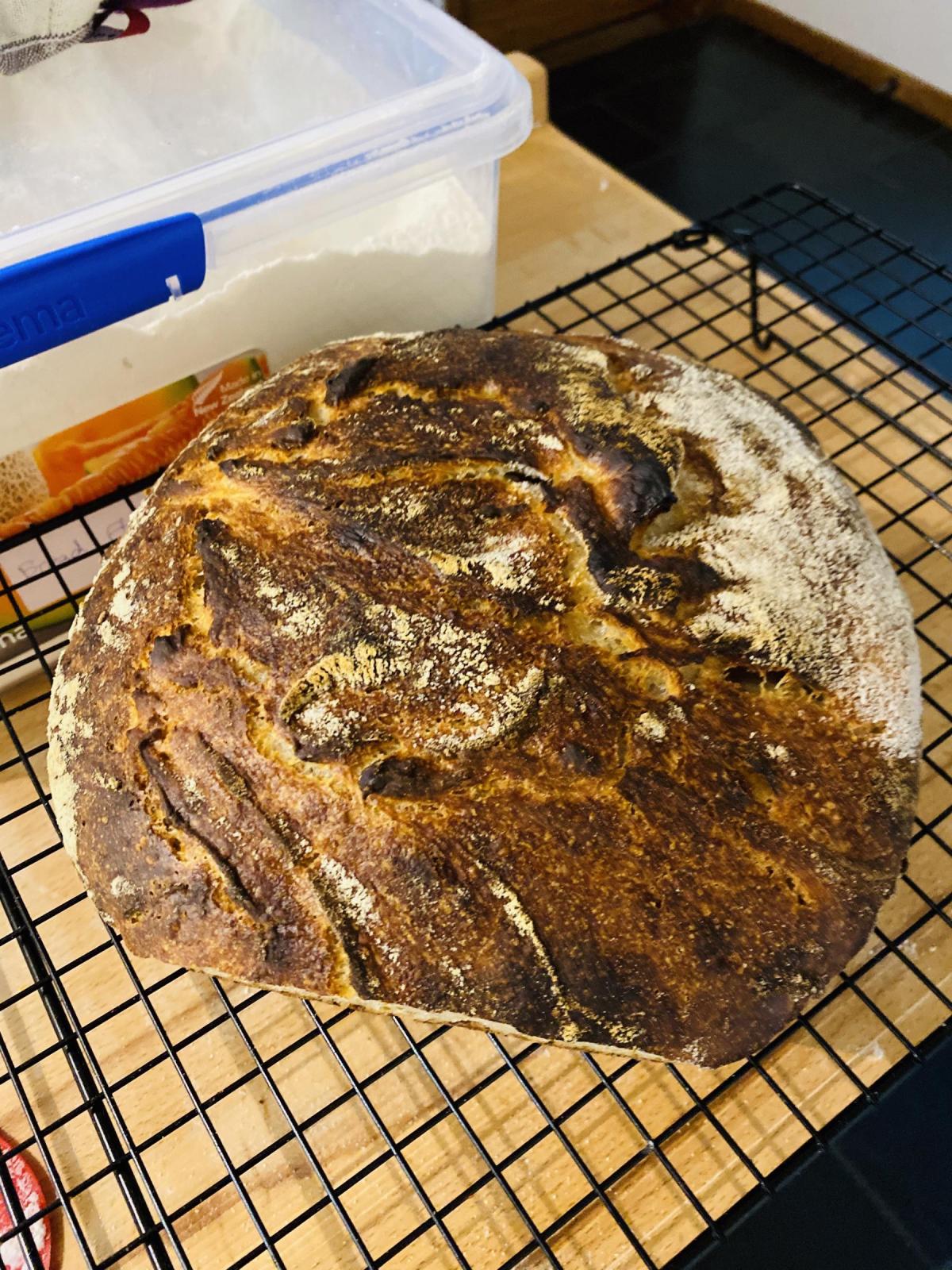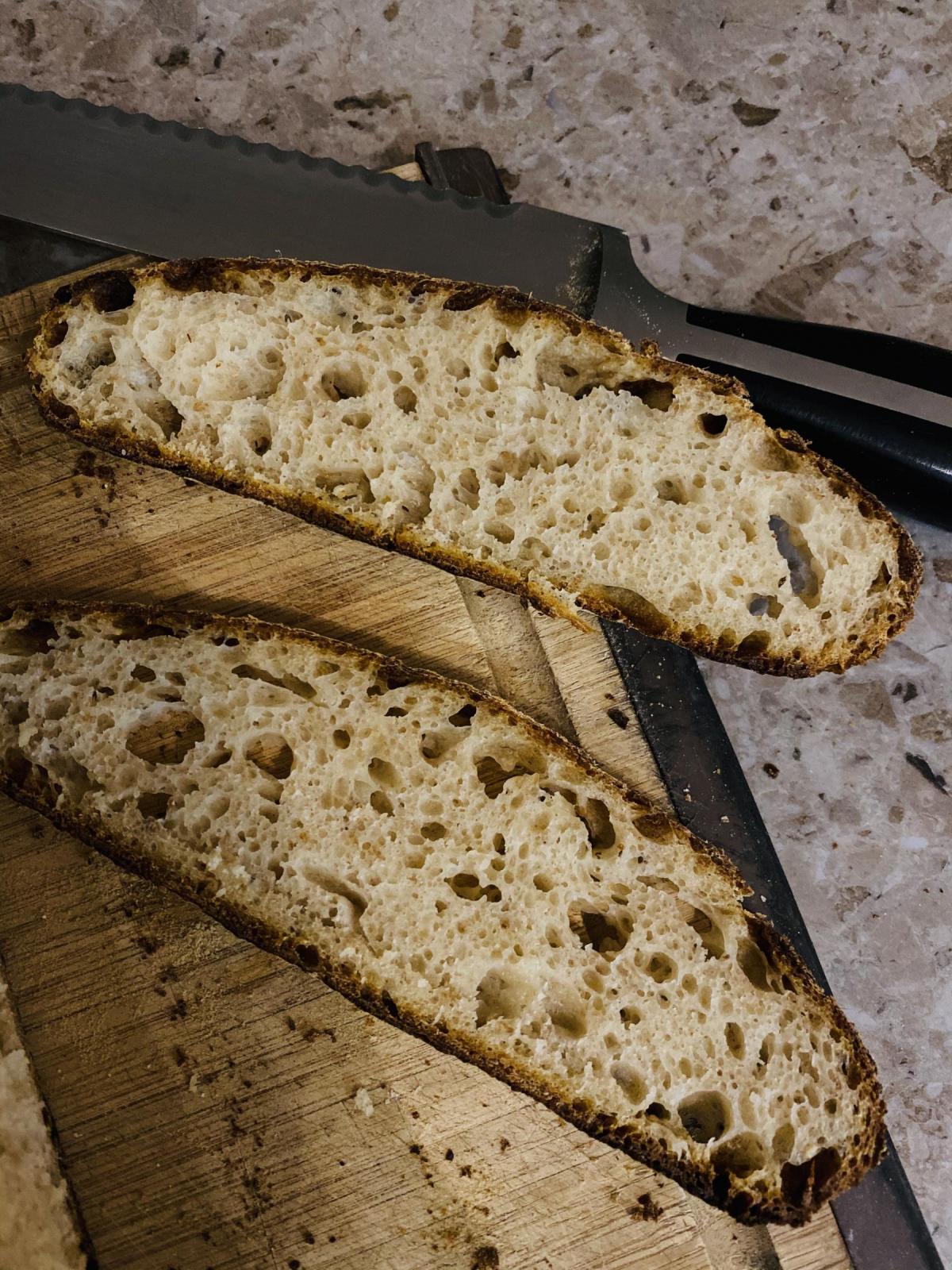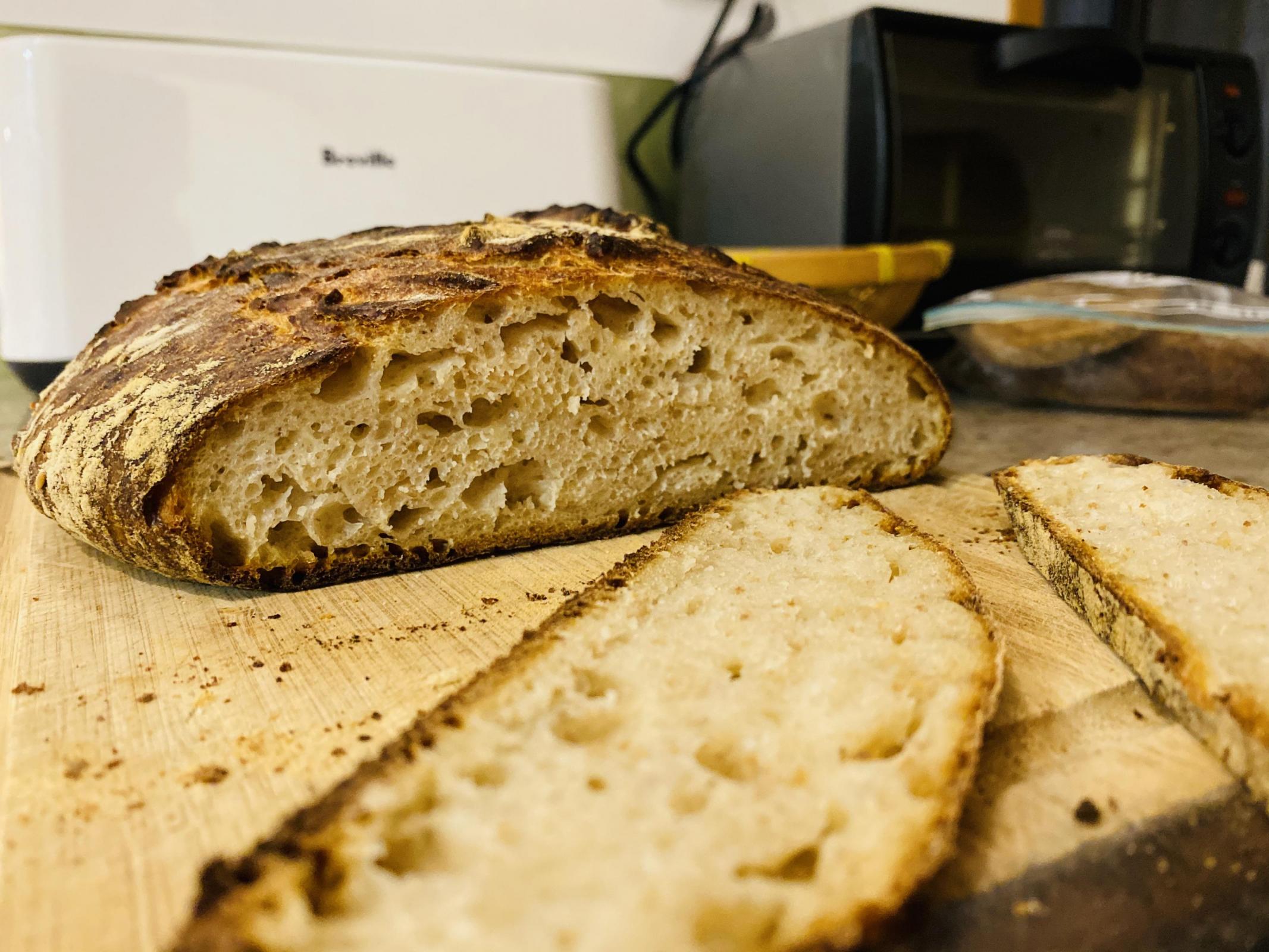Hi,
New bread and especially sourdough baker here. I've been reading posts here and learned so much. Thank you all the experience bakers here.
I have chosen the tartine bread as first loaf to try my hands on, not much luck so far. My starter is only a bit more than a month old. I keep it in the fridge as I only bake a couple of times a week. I followed the book's instruction to make the levain the night before, add water and flour to the cold starter directly out of fridge.
The next day, I make the dough and have always tried to bake the bread same day. The first couple of loafs were definitely under proofed, as I was following the time frame without checking how the dough should feel or look like. It seems my dough grows way slower than suggested 3-4 hours. I usually leave it in the oven with the pilot light on (77-80F), I'm currently in New Zealand, kitchen temperature is around 65-68F during the day, seems too low for my dough.
With this last loaf, I reduced water by 25g as it's always too wet to handle (I halved the recipe to make one loaf), the dough was mixed around 10:30 in the morning, left on kitchen counter for a couple of hours to get a bit of sun, then when the sun is gone I put it in the oven, by early evening it only grew by about 20%. Could this be because my starter is too young?
I shaped the dough in the evening and popped it in the fridge to proof overnight. The next morning, I took the dough out around 8am, a bit growth, not much. I finally baked around 12:00pm. I don't have a banneton and have always after shaping put the dough in a glass bowl lined with kitchen towel. No matter how much flour or rice flour I dust both the bowl and the dough, it always sticks badly, makes getting it onto the baking stone or into the dutch oven a nightmare.
Here I attached three pictures. The first one shows all the creases resulted from dough sticking to the Kitchen towel when I got it into the dutch oven, second one is the crumb. Crumb definitely has improved since my first try (I think this is my 7th loaf). But I'm still not sure whether it's a bit under proofed. With the speed of my dough, I doubt it's over proofed... The last one shows the height of the finished bread, it never rises much, could it be a result of surface ruined by sticky towel? Any comments will be appreciated. Thank you very much.



Lijie
How old was the starter when you start to putting it in the fridge?
If you feed it 1:1:1 how long does it takes before it doubled in size or start valling down again?
This should happen in about 4 ours at 78 degrees.
Hi dbazuin, thank you for the question. Starter has stayed in the fridge from the moment it's ready to be used. I made it less than 2 months ago. I only bake sporadically, at most 3 times a week, so I didn't keep it at room temperature, in which case I have to feed it everyday.
I've always fed it at night and by following morning, it usually grows by about 30%, temp in the kitchen at night probably hover around 60 or so (maybe even lower). I'll take it out tomorrow and wait for it to go back to room temperature to feed it and see how long it takes t double.
Probably a stupid question, if I start feeding it everyday from now on for a while to make it more active, will it stay that level of activity once I put it back in the fridge and only feed couple of times a week again?
I asume it wil.
If you feed it often enough maney once in a week.
Much that we all want to emulate Chad Robertson in a few weeks, his recipes are the equivalent of long-distance runs for a rookie runner :there's going to be a lot of pain and suffering and successful outcomes will be few and far between.
I suggested a few days back to someone in your position to start with easier recipes that will get you nice open crumbs (alas not Tartine Book picture perfect crumbs) and will serve you as training wheels. In a previous post, I made reference to someone else in the Forum, Alfanso, on whose shoulders many of us stand on as bakers.
Friendly advice from a novice baker, bake this 10 times successfully then go back to Mr Robertson's book. Your self-esteem as a baker will be thankful for it.
This is the thread where Alfanso shares his wisdom:
http://www.thefreshloaf.com/node/63699/baguette-practice
And this is the thread where wee were talking a baker in a situation similar to yours to take Alfanso's sound advice and get training bakes with easier recipes than Tartine.
http://www.thefreshloaf.com/node/64212/dough-very-wet-shapeless-70-what-am-i-doing-wrong
Safe bakes.
Hi Drainaps, thank you for the advice! I actually didn't know Tartine bread is a difficult one and meant for more experienced bakers, of course that became obvious after my fifth failed loaf! I chose it because I like his idea of using a young levain and short fermentation time, because like him, I also don't like bread that goes through a very long proofing and that are very sour.
I'm definitely trying that recipe from Alfanso, love the hydration rate there!
Don’t worry, We all have been there and we know for a fact how frustrating it is. Alfanso’s recipe is a pleasure to work with, actually I’ll be mixing it today and baking it tomorrow for weekend bread and you can get very very very nice Instagram-quality crumbs too. Actually I was surprised the first time I baked it at how my crumb was way better than any previous attempts at high-hydration. It was a big morale booster. Please keep in mind you still need to get the basics right, and be soft on the forming.
In my limited experience, inadequate forming kills in a matter of minutes many hours of proper fermentation.
Let us know how it goes.
Hi Lijie,
Thanks for posting. I too am a Tartine beginner so please receive these comments as those from a fellow learner going through a similar process.
My first loaf was so wet and sticky, I couldn't form it. Frustrating but...a short search for help lead me to The Fresh Loaf website!
I have to say everything changed when I really focussed on my starter. I kept it on the countertop and fed it once a day at relatively the same time and was exact with weights ( 100% hydration). I didn't bake with it- just kept it in a glass jar so I could see how much and when it was rising and falling. I learned there is a huge difference between an "active" starter and one cold from the fridge- like basically the difference between a live thing and a half asleep struggling thing!
Loaves 3-5 got much better with the stronger warmer starter: better rise and way less sticky. It wasn't as soft and pliable as the yeasted dough I was familiar with but was heading in that direction. This allowed for the focus to shift onto shaping the loaves and getting that all important surface tension. All I can say is the one side floured, one side not and how much flour you use is key. That was all such a mystery, but I found a couple youtube videos which really helped a lot. Getting a good taut shape (beginner style) in the the last loaf ( 6) also meant it was the first one I could cut the top with a razor blade. This is the part I now look forward to in making my next loaf- where it was the part I feared most in the early loaves when I dumped that unholy mess on the countertop. A little flour in the right places makes all the difference.
There isn't a bench knife or banneton available to buy in England these days, so I'm using a 6" plaster knife (works great) and a glass bowl with a cotton tea towel. Every loaf was sticking to the towel like you are experiencing. So heartbreaking to deflate your loaf after all that work isn't it? Someone somewhere recommended potato or corn starch. I rubbed potato starch into the towel and it's worked like a dream. Also I've found polenta or semolina on the loaf / bottom of the dutch oven keeps it from sticking to the pan. Had one loaf stick so badly it had to be torn out...made great Panzanella though.
The first loaf out of the oven convinced me to stick with the Tartine recipe- such a great taste and that crackly crust...
As you can see from the photos posted below, I'm not baking an instagrammable loaf, but it's improving as I work with one variable at a time while learning.
I'm sure there are many experienced bakers on this site who will give you excellent advice to achieve the results you desire. Mostly I just wanted to let you know there are other ( at least one) Tartine beginners out there with you, seduced by this loaf and mucking their way through!
Hi PNWSouthcoaster, thank you so much for your sweet message! I'll be very pleased if I get crumb like yours! I have to try the potato starch method. Putting the dough in the dutch oven is the moment I dread the most every time. It's absolutely heartbreaking to see the dough deflate or even torn after such a long wait.
May I ask how long did you feed the starter daily before you see the difference it made to the dough? And what's the ratio between starter and flour? Tartine or not, I guess if my starter is not at the right stage nothing good can come out of it.
Hi Lijie,
Thank you for the crumb compliment! It wasn't very clear in the photos that the first picture was loaf 2 and the other picture was loaf 6. You can see how the shape of the loaf really changed after I strengthened the starter and got more practice handling the dough in the shaping- and no sticking to the cloth of course.
To start the starter from scratch took maybe a week before it appeared to be starter-like, but I now realize it wasn't very strong or consistent. I never put it in the fridge but always had some discard as a backup in the fridge ( still do).
I want to say I watched my starter rise and fall over about 3 -4 days? It's a slow process so I didn't watch it like a tv show- but just checked it every few hours to see when it started rising, when it peaked and when it started to fall. I didn't put it in the fridge at all during this time and marked on my starter container times to see the difference day to day. Once it was consistent ( Hitting the same marks at the same-ish times) I baked a loaf and although still a wet dough, was so much easier to handle and the feel of the dough was better.
I've attached a couple photos below of my starter now- before feeding actually so its at the end of the cycle but it looks bubbly and happy to my untrained eye. The other photo shows the marks on the side- the tape I use to mark the beginning "just fed" level.
When you ask the ratio of starter to flour do you mean to feed the starter or to make the loaf? I haven't deviated from the Tartine recipe- except I make one loaf at a time. With the entire country doing home bake offs, flour is hard to come by so I can only handle a 500g fail !
Feeding the starter I do 25g starter, 50g water, 25g white bread flour, 25g whole wheat bread flour. Currently I'm feeding it once a day usually in the morning.
For the loaf I was making 200g leaven but have now cut that down to about 120g - 135g since I only need 100g for the actual dough (once again flour conservation :-)
Robertson says use 1 Tablespoon mature starter for 400g leaven. I'm cutting the recipe in half but I'm using between 20-35g starter in my 120-135g leaven, which is way more than the 1/2 tablespoon a true halved recipe would be. Wait- did I say I wasn't deviating from the recipe?! I'm sure all those ratios make a difference but I'll figure that out later I suppose...
Is there a particular reason you're leaving your starter in the fridge? Are you feeding it every day?
All the best and let us know how you're getting on !
Hi PNWSouthcoaster, thanks for the reply! I put the starter in the fridge as I don't bake everyday, so I don't want to feed it everyday and end up with lots of discard. I don't want to throw away any discard, which means I'll have to use it to bake some other stuff. We are a small household of two adults and two little boys, we simply don't have that much baking needs.
Having said that, I took the starter out last night because I want to try the Vermont sourdough suggested by drainaps. I fed it at 10:50 this morning with bread flour only, around 1:3:3. Kept it in the oven at around 70F. It only doubled now, at 8pm! So I guess my starter definitely needs to be more active for me to make decent sourdough bread. I'm going to keep feeding it daily in the morning for a week and then try again. Thanks again for the help!
Totally understand the discard issue! You got me thinking about my starter again. I started to follow the Full Proof Baking regime on youtube to see if it makes any difference in my loaf. Pretty intensive though...
Best of luck with your next loaves!
I would like to also get some advice on whether I'm treating my starter well.
I keep it in the fridge, very small amount, around 30 gram. When I want to make bread, I take it out, without waiting for it to come back to room temperature, add the exact amount of flour and water (1:1 ration) mix that's called for. Then once it has ripened, I take the amount I need, and pop the left over (again 30 gram) back to the fridge without feeding, until I need it next time.
Is this ok???
When it is well developed and you bake at least once in a week or maybe two weeks.
This works fine.